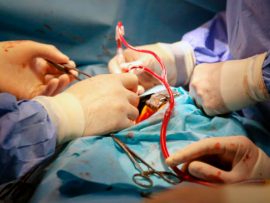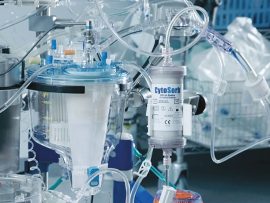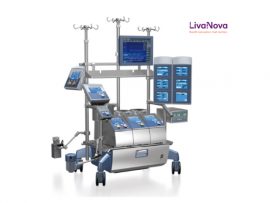Abstract To the Editor, After more than a decade of focused research, significant advancements have been made in the technology of cardiopulmonary bypass perfusion (CPB) for Type A aortic dissection (TAAD). Notably, there has been..
Read MoreAbstract Objectives Myocardial revascularisation and cardiopulmonary bypass (CPB) can cause ischaemia-reperfusion injury, leading to myocardial and other end-organ damage. Volatile anaesthetics protect the myocardium in experimental studies. However, there is uncertainty..
Read MoreAbstract Effect of Cardiopulmonary bypass on Lungs: organ damage during cardiac surgery has been primarily attributed to the use of CPB. Pulmonary function in patients after CPB is consistently altered..
Read MoreAbstract Cardiopulmonary bypass (CPB) can alter pharmacokinetic (PK) parameters and the drug may adsorb to the CPB device, altering exposure. Cefazolin is a beta-lactam antibiotic used for antimicrobial prophylaxis during..
Read MoreAbstract OBJECTIVES Activated clotting time (ACT) is commonly used to monitor anticoagulation during cardiac surgeries. Final ACT values may be essential to predict postoperative bleeding and transfusions, although ideal values..
Read MoreAbstract Optimal oxygen management during pediatric cardiopulmonary bypass (CPB) is unknown. We previously demonstrated an increase in cortical mitochondrial reactive oxygen species and decreased mitochondrial function after CPB using hyperoxic..
Read MoreAbstract OBJECTIVES Postoperative organ dysfunction is common after cardiac surgery, particularly when cardiopulmonary bypass (CPB) is used. The Sequential Organ Failure Assessment (SOFA) score is validated to predict morbidity and..
Read MoreAbstract Objective: Femoral artery cannulation is the most commonly used approach for cardiopulmonary bypass (CPB) in robotic cardiac procedures. However, without adding a distal perfusion cannula, leg ischemia can occur..
Read MoreAbstract Introduction Extracorporeal techniques have been present in medicine for over 70 years. Many factors in history have influenced their development and popularisation, in particular the first discoveries of heparin..
Read MoreAbstract Background Perioperative myocardial injury (PMI) is associated with increased mobility and mortality after noncoronary cardiac surgery. However, limited studies have developed a predictive model for PMI. Therefore, we used..
Read MoreAbstract Introduction and importance Perioperative anesthetic management in cases of severe airway obstruction with positional symptoms can be associated with difficulties in ventilation or intubation, with a risk of acute..
Read MoreAbstract Introduction Prevention of acute kidney injury during cardiopulmonary bypass (CPB) is still a challenge and has been the object of numerous studies. The incidence of acute kidney injury in..
Read MoreAbstract Alagille syndrome is an autosomal dominant disorder that is caused by heterozygous mutation of JAG1 or NOTCH2 gene that impacts several multisystem organs including but may not be limited..
Read MoreAbstract Rationale Acute renal failure (ARF) is one of the most serious complications of cardiopulmonary bypass (CPB) surgery. Serum creatinine level is a key compound examined to understand whether renal..
Read MoreAbstract Early cardiac surgery in neonates and infants with congenital heart disease has been performed since the middle to late years of the twentieth century. To date, there are very..
Read MoreAbstract Introduction Postoperative delirium (POD) has a major impact on patient recovery after cardiac surgery. Although its pathophysiology remains unclear, there could be a correlation between cerebral blood flow (CBF)..
Read MoreAbstract Background Acute microcirculatory perfusion disturbances and organ edema are important factors leading to organ dysfunction during cardiac surgery with cardiopulmonary bypass (CPB). Priming of the CPB system with crystalloid..
Read MoreAbstract Dear Editor, Acute kidney injury (AKI) frequently occurs as a complication in patients undergoing cardiac surgery, with reported incidence rates ranging from 20 to 40% []. The development of..
Read MoreAbstract Cardiac surgeries under cardiopulmonary bypass (CPB) are complex procedures with high incidence of complications, morbidity and mortality. The inhaled nitric oxide (iNO) has been frequently used as an important..
Read MoreAbstract Background Oxygenators, as used in cardiopulmonary bypass (CPB) circuits, are components with good air removal properties. However, under some conditions the semipermeable characteristics of hollow fibers allow air to..
Read MoreAbstract Objectives Previous studies in other settings suggested that urine output (UO) might affect NephroCheck predictive value. We investigated the correlation between NephroCheck and UO in cardiac surgery patients. Design..
Read MoreAbstract Purpose: There is currently no consensus on the most appropriate blood transfusion strategy for older adults undergoing cardiovascular surgery. We aimed to investigate the potential benefits of the patient blood..
Read MoreAbstract Background One of the main goals of cardiopulmonary bypass (CPB) is targeting an adequate mean arterial pressure (MAP) during heart surgery, in order to maintain appropriate perfusion pressures in..
Read MoreAbstract Introduction We aimed to compare the inflammatory cytokines levels of the miniaturized and conventional extracorporeal circuit system. The miniaturized extracorporeal circuit system may be fewer possible inflammation-induced or blood..
Read MoreAbstract Background Various factors can cause vascular endothelial damage during cardiovascular surgery (CVS) with cardiopulmonary bypass (CPB), which has been suggested to be associated with postoperative complications. However, few studies..
Read MoreAbstract Background Extracorporeal blood purification has been widely used in intensive care medicine, nephrology, toxicology, and other fields. During the last decade, with the emergence of new adsorptive blood purification..
Read MoreAbstract Background The relationship between venous congestion in cardiopulmonary bypass (CPB) and acute kidney injury (AKI) in cardiac surgery has not utterly substantiated. This study aimed at investigate the relationship..
Read MoreAbstract It is believed that a lower temperature setting of hypothermic circulatory arrest (HCA) in thoracic aortic surgery causes coagulopathy, resulting in excessive bleeding. However, experimental studies that eliminate clinical..
Read MoreAbstract Objective: We aimed to evaluate the effects of cardiopulmonary bypass (CPB) machines used in coronary artery bypass grafting surgeries on cerebral perfusion by performing cerebral oximetry monitoring [near-infrared..
Read MoreAbstract Since the risk factors for heparin resistance (HR) before cardiopulmonary bypass (CPB) have not been fully clarified, this study investigated the contributing factors for HR after the initial unfractionated..
Read More


















